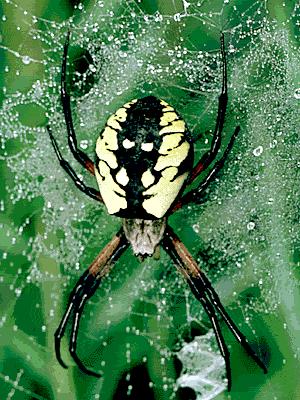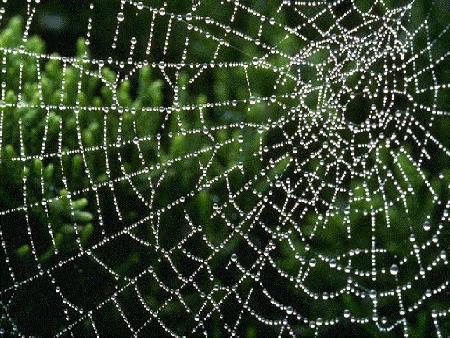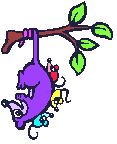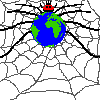|
|
Canku Ota |
|
|
(Many Paths) |
||
|
An Online Newsletter Celebrating Native America |
||
|
November 3, 2001 - Issue 48 |
||
|
|
||
|
Grandmother Spider Steals the Fire |
||
|
Mississippi Choctaw Legend |
|
|
|
Print and Color Your Own Grandmother Spider |
|
|
 Grandmother
Spider, who weaves existence together like great strands of a web, is an important
symbol to many American Indian People. Learning the stories of Grandmother Spider can help one understand that
we are all connected. By dishonoring one, we dishonor ourselves. Grandmother
Spider, who weaves existence together like great strands of a web, is an important
symbol to many American Indian People. Learning the stories of Grandmother Spider can help one understand that
we are all connected. By dishonoring one, we dishonor ourselves.Description The 1 1/8-inch long golden garden spider, Argiope aurantia, is one species of argiope orb weavers. The adult female is predominately black with yellow or orange markings on the abdomen, and circular bands of yellow evident on the legs. Range and Habitat This species can be found throughout the United States and southern Canada. They construct large orb webs between shrubs or herbaceous vegetation, spinning homes that may reach a diameter of 2 feet, although they seem much larger to the gardener who walks into one. Silk support strands maintain the shape of the web while sticky spirals of silk are used to capture prey. Displayed in the center of the orb is a zigzag pattern of heavy silk that adds strength to the web, helps to camouflage the similarly designed spider, and may even be of value in attracting insects to the web. Spider webs are truly miracles of engineering, as well as beautifully designed artworks. Orb-building spiders begin their webs with a central hub . The hub is surrounded by a 'free zone', in which the spider can move around unhampered by intricate spiralling threads. From the hub come 25 to 30 dry radial threads, which connect to strong frame threads around the outer perimeter of the web. Spiralling threads go from outside of the free zone to the edge of the web, and sticky threads, running from the outside to the free zone, are spun last and coated with sticky droplets. The spider waits in the center of the web until a careless insect becomes caught in the sticky threads, and then she runs to wrap it up and paralyze it, storing it for future use.  Natural History The female golden garden spider sits in the center of the web during the day, holding the end of her abdomen upward and aiming her eyes and mouth-parts downward. She also places her legs together in pairs, which gives the appearance of four legs instead of the legal limit of eight. When disturbed, the spider will vibrate the silk orb, giving the appearance of a larger, more threatening foe. If this doesn't work, she will drop to the ground and hide. The much smaller male spider, in the short time he is around, builds a rather unimpressive web at the outer edge of the female's. He feeds and waits until his mate is receptive, at which point he fulfills his duties and is probably devoured for his efforts. In late summer and fall, the mature female spends most of her time feeding on any insect tangled in her web; she prefers larger prey, especially grasshoppers. Egg sacs are produced in late fall, and the soon-hatched spiders remain protected within the sac until spring, when they emerge and disperse. |
|
Golden
Garden Spider |
|
|
||
|
|
||
| Canku Ota is a free Newsletter celebrating Native America, its traditions and accomplishments . We do not provide subscriber or visitor names to anyone. Some articles presented in Canku Ota may contain copyright material. We have received appropriate permissions for republishing any articles. Material appearing here is distributed without profit or monetary gain to those who have expressed an interest. This is in accordance with Title 17 U.S.C. section 107. | ||
|
Canku Ota is a copyright © 2000, 2001 of Vicki Lockard and Paul Barry. |
||
|
|
|
|
|
The "Canku Ota - A Newsletter Celebrating Native America" web site and its design is the |
||
|
Copyright © 1999, 2000, 2001 of Paul C. Barry. |
||
|
All Rights Reserved. |
||

 The Choctaw
People say that when the People first came up out of the ground, People were encased in cocoons, their eyes closed,
their limbs folded tightly to their bodies. And this was true of all People, the Bird People, the Animal People,
the Insect People, and the Human People. The Great Spirit took pity on them and sent down someone to unfold their
limbs, dry them off, and open their eyes. But the opened eyes saw nothing, because the world was dark, no sun,
no moon, not even any stars. All the People moved around by touch, and if they found something that didn't eat
them first, they ate it raw, for they had no fire to cook it.
The Choctaw
People say that when the People first came up out of the ground, People were encased in cocoons, their eyes closed,
their limbs folded tightly to their bodies. And this was true of all People, the Bird People, the Animal People,
the Insect People, and the Human People. The Great Spirit took pity on them and sent down someone to unfold their
limbs, dry them off, and open their eyes. But the opened eyes saw nothing, because the world was dark, no sun,
no moon, not even any stars. All the People moved around by touch, and if they found something that didn't eat
them first, they ate it raw, for they had no fire to cook it.



 Then a small voice said, "We will take it, if Grandmother Spider will help." The timid
humans, whom none of the animals or birds thought much of, were volunteering!
Then a small voice said, "We will take it, if Grandmother Spider will help." The timid
humans, whom none of the animals or birds thought much of, were volunteering!